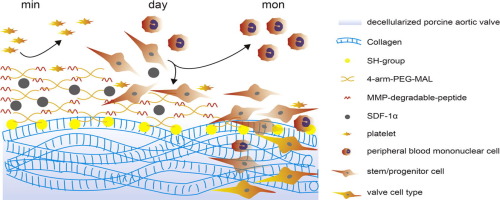Acta Biomaterialia ( IF 9.4 ) Pub Date : 2019-02-02 , DOI: 10.1016/j.actbio.2019.02.002 Jinchi Dai , Weihua Qiao , Jiawei Shi , Chungen Liu , Xingjian Hu , Nianguo Dong

|
Decellularized matrix is of great interest as a scaffold for the tissue engineering heart valves due to its naturally three-dimensional structure and bioactive composition. A primary challenge of tissue engineered heart valves based on decellularized matrix is to grow a physiologically appropriate cell population within the leaflet tissue. In this study, a composite scaffold was fabricated by the combination of a porous matrix metalloproteinase (MMP) degradable poly (ethylene glycol) (PEG) hydrogel that were loaded with stromal cell-derived factor-1α (SDF-1α) and a mechanically supportive decellularized porcine aortic valve. Results demonstrated that the modified scaffold enhanced bone marrow mesenchymal stem cells (BMSC) adhesion, viability and proliferation, and promoted BMSC differentiate into valve interstitial-like cells. Furthermore, these modifications lead to enhanced protection of the scaffold from thrombosis. In vivo assessment by rat subdermal model showed the modified scaffold was highly biocompatible with tissue remodeling characterized by promoting mesenchymal stem cells recruitment and facilitating M2 macrophage phenotype polarization. The surface layers of PEG hydrogel not only could provide a niche for cell migration, proliferation and differentiation, but also protect the scaffolds from rapid degeneration, inflammation and calcification. The intermediate layer of decellularized valve could maintain the organization of the scaffold and perform the valve function. The promising results emphasize the potential of our scaffolds to improve recellularization and promote remodeling of implanted decellularized valves. These findings suggest that the SDF-1α loaded MMP degradable PEG hydrogel modification could be an efficient approach to develop functional decellularized heart valve.
Statement of Significance
A composite scaffold was fabricated by the combination of a porous matrix metalloproteinase (MMP) degradable poly (ethylene glycol) (PEG) hydrogel that were loaded with SDF-1α and a mechanically supportive decellularized porcine aortic valve. The surface layers of PEG hydrogel not only could provide a niche for cell migration, proliferation and differentiation, but also protect the scaffolds from rapid degeneration, inflammation and calcification. The intermediate layer of decellularized valve could maintain the organization of the scaffold and perform the valve function. The promising results emphasize the ability of our scaffolds to improve recellularization and promote remodeling of implanted decellularized valves. This suggests that the extracellular matrix-based valve scaffolds have potential for clinical applications.
中文翻译:

基质细胞衍生因子-1α负载蛋白水解可降解水凝胶修饰脱细胞的主动脉瓣支架,以进行脱细胞和重塑。
作为组织工程心脏瓣膜的支架,脱细胞基质由于其天然的三维结构和生物活性成分而引起了极大的兴趣。基于脱细胞基质的组织工程心脏瓣膜的主要挑战是在小叶组织内生长生理上合适的细胞群。在这项研究中,复合支架是由多孔基质金属蛋白酶(MMP)可降解的聚(乙二醇)(PEG)水凝胶与基质细胞衍生因子1α(SDF-1α)负载组合而成的去细胞猪主动脉瓣。结果表明,修饰的支架增强了骨髓间充质干细胞(BMSC)的黏附,生存能力和增殖,并促进了BMSC向瓣膜间质样细胞的分化。此外,这些修饰导致增强的支架免受血栓形成的保护。通过大鼠皮下模型的体内评估表明,修饰的支架与组织重塑具有高度生物相容性,其特征在于促进间充质干细胞募集并促进M2巨噬细胞表型极化。PEG水凝胶的表面层不仅可以为细胞迁移,增殖和分化提供利基,而且可以保护支架免受快速变性,炎症和钙化的影响。去细胞瓣膜的中间层可以维持支架的组织并执行瓣膜功能。有希望的结果强调了我们支架改善再细胞化和促进植入的去细胞瓣膜重塑的潜力。
重要声明
通过将多孔基质金属蛋白酶(MMP)可降解的聚(乙二醇)(PEG)水凝胶(装有SDF-1α)和机械支持的脱细胞猪主动脉瓣膜结合起来,制成复合支架。PEG水凝胶的表面层不仅可以为细胞迁移,增殖和分化提供利基,而且可以保护支架免受快速变性,炎症和钙化的影响。去细胞瓣膜的中间层可以维持支架的组织并执行瓣膜功能。有希望的结果强调了我们支架改善再细胞化和促进植入的去细胞瓣膜重塑的能力。这表明基于细胞外基质的瓣膜支架具有临床应用潜力。































 京公网安备 11010802027423号
京公网安备 11010802027423号